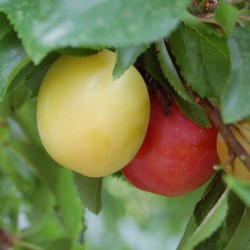Special Offers
Redeem Offer Code
Redeem Gift Voucher
Scarecrow Members
Our Feedback
Re order earlier this year of 40 fuchsia plants. They have flowered well since planting on arrival.Out of the 40 received I have lost 1 due to a neighbours cat.Very pleased and would recommend Victoriana to friends and family.
Sue Burkinshaw, Sheffield
Cherry Plum Hedging






Prunus cerasifera Myrobalan Group
- A fast growing hedging plant that fruits! Well worth growing.
- Delicious fruits a little larger than a cherry but with a flavour similar to plums are produced in profusion.
- Sometimes known as the Myrobalan Plum
Supplied as a bare root plants pruned to approximately 2 feet (60 cm) tall including roots.
Available from APPROXIMATELY late November / early December5 or more £2.85GBP each. Group & quantity discounts
Currently Not Available to Buy
Description
Now, this really is special and almost lost from cultivation. A most worthwhile and fast growing hedging plant with the added bonus of tasty red or yellow fruits the size of cherries but the shape of plums (hence the name Cherry Plum) - get these before your children do! In our experience the birds tend to leave them alone! Before its leaves appear the branches are smothered in white flowers.
Sometimes known as the Myrobalan Plum. This was once grown as a shelter belt for orchards and we have traced this use back to the 1700's. Make jam, wines or even liqueurs from the fruits. Forms a very dense hedge of thorny twigs making it an extremely effective barrier.
Leaves and seeds contain toxins making them bitter to eat, but in large quantities can be poisonous. The fruits are, of course, safe to eat (but spit the pips out!)
Recommended by the RHS to be an excellent attractant and nectar source for bees and other beneficial insects.
- Plant 18" (45 cm) apart.
- Ultimate height 25 feet (7.5 metres). Can be trimmed to any height above 4 feet (120 cm). Average annual growth rate 1 - 2 feet (45 - 60 cm).
- Ultimate width 12 feet (3.5 metres). Can be trimmed to any width over 2 feet (60 cm).
- Grows well in most soil types (including chalky and clay) except those prone to laying wet.
- Suitable for most aspects from full sun to partial shade. Does not perform well in dense shade.
- Suitable for coastal areas.
- Performs well in exposed / windy positions.
- Plant Autumn / Winter / early Spring.
Cultural Guidance
On Arrival
- If the plants are dry stand the plants in a bucket of water for no more than half an hour.
- Ideally they should be planted out as soon as possible; if this is not possible either 'heel' the plants into a shallow trench or alternatively wrap the roots back up in the bark chip and polythene they arrived in and store the plants in a cool frost free place - do not keep them in a warm place as they will start to come into growth prematurely. Check that the roots are kept moist every few days and plant out as soon as practical.
- Before planting incorporation of organic matter such as well rotted manure (not fresh) or compost will give your plants the best start. Under no circumstances should you use any stimulants, fertiliser or bonemeal at planting time as such products will 'burn' any new root growth and actually slow your plants' development!
- Water as necessary, particularly during their first year.
After Care
- Keep your developing hedge free of weeds.
- At the beginning of each spring your plants will benefit from a mulch of well-rotted manure, bark chip or something similar. This will reduce the need for weeding and help with moisture retention. At the same time you can also lightly top-dress along the row with a balanced base fertiliser.
- Once established the hedge can be cut with conventional hedge cutters, preferably in winter before the birds start nesting!
How To...
How To Plant Cherry Plum Hedging, Conservation Hedging, Coral Pearls Hedging, Whispering Willows
Detailed advice on planting out different varieties of hedging.
General Information
Pollinator Friendly Plants
A detailed guide to the seeds and plants sold by Victoriana Nursery Gardens that will attract and provide a food source to bees and other beneficial pollinating insects.

 01233 740529
01233 740529


